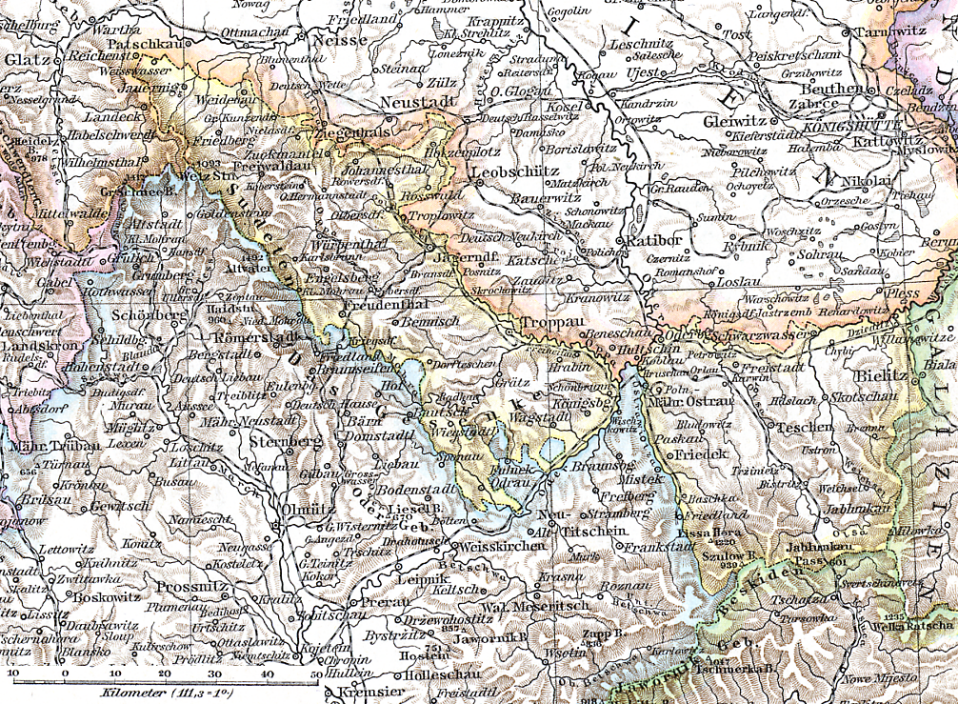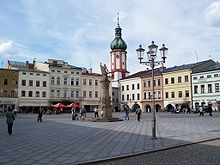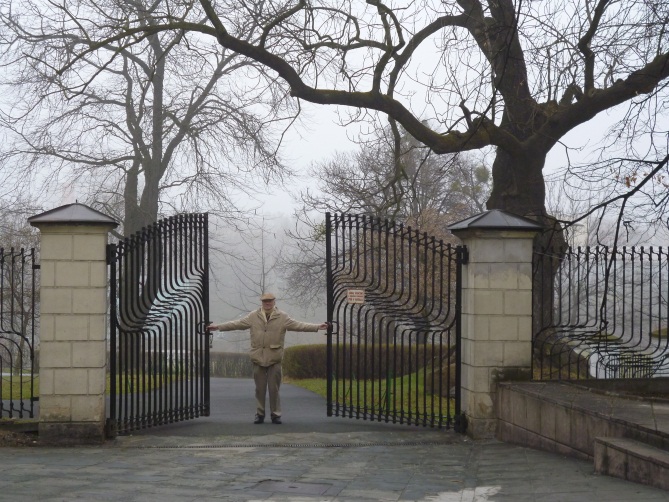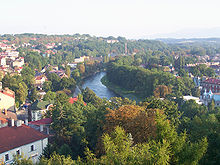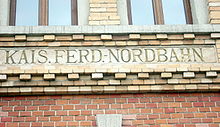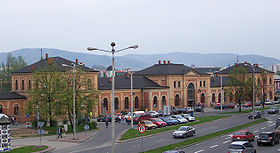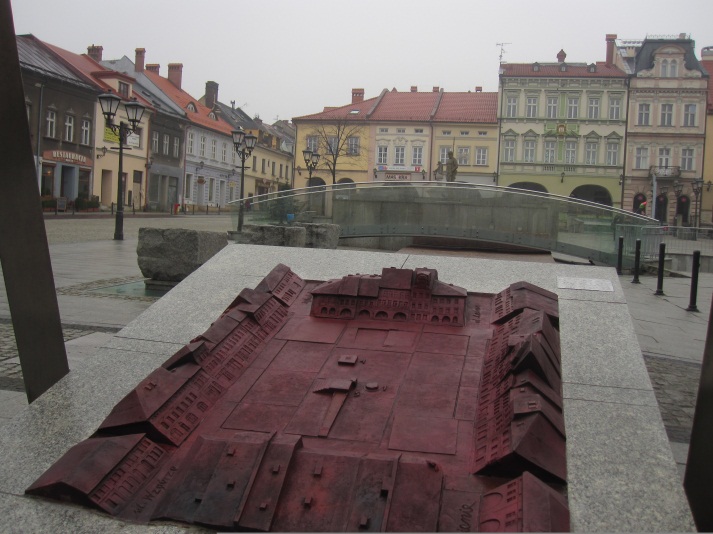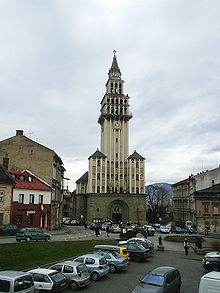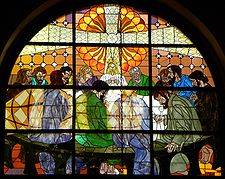What is today northern Moravia was in the monarchy a 3-5 country mixture, see the map from Wikipedia. After 1804 and the Vienna congress the Kronland and Herzogtum Austria-Silesia was created until WW! (1918). Its capital was Troppau (Opava) and it consisted of 2 separated parts: Herzogtum Austria-Silesia and Herzogtum Teschen. Between these 2 parts there was a small cone of the crownland Moravia, that led to the city of Mährisch-Ostrau (M. Ostrova). To the East of Teschen was the crownland Galicia and south of Austria-Silesia was the crownland Bohemia. Now those four parts belong to the Czech Republic, only the Teschen part was split between the Czech and the Polish state, while the northern Prussian and Polish part of Silesia belongs to Poland.
There are 2 Frýdlant with castles in the Czech Republic (CZ), one in northern Bohemia that Wallenstein got as reward from the Kaiser for being famous and victorious general in the 30 years’ war, and this one here in Moravia on the train track between Olomouc and Frýdek-Myste
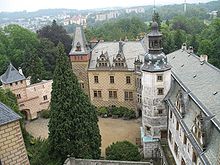 Frýdek-Mystek is “Janitzki country”, because the aunt of my wife Hanka who passed on her house in Vienna to our daughter. The parents of aunt Janitzki are buried at the cemetery of Frýdek-Mystek. That is the twist of fate: The mother line of my wife and my father line had been separated in Moravia 100 years ago just by some small distance. So we passed on our Moravian genes for another generation.
Frýdek-Mystek is “Janitzki country”, because the aunt of my wife Hanka who passed on her house in Vienna to our daughter. The parents of aunt Janitzki are buried at the cemetery of Frýdek-Mystek. That is the twist of fate: The mother line of my wife and my father line had been separated in Moravia 100 years ago just by some small distance. So we passed on our Moravian genes for another generation.
Wet weather and a 4 lane high way brought us right to the double city of Frýdek-Mystek. After some detour we found the bridge to the Frýdek part of the city on the other side of the river with a large town square and a white castle (Zamek) at the end. The inner court of the castle opened to an iron gate to the castle park.
The castle was open for visit and has 2 exhibitions: the Beskid museum and the permanent castle exhibition for 40 Kronen. No other tourists seem to be around in this drizzling weather. Right now I can only visit the Beskid museum said the lady in English. “Do you speak German”, she asked, and, saying yes, she handed me over to her younger colleague. I asked what to see in the museums or if she has some pictures or descriptions of it. She gave me the same type of general regional booklets I got just before in Frenstat. The tired part of the visiting party has not followed this information exchange and was already sitting in the coffee house next to the Zamek; well, at this point I decided to join them. The menu card was in English and I had a noodle soup since the translation of the other 2 soups contained Czech- English words that the waiters could not explain to us.
After warming up we left the city in direction to the Polish border at Těšín. A new highway was built connecting to the Polish border, but we did not know how and if we should pay for the few kilometers, so we reached the Czech part of Těšín where a big train station and the river blocked an easy access to Poland. Also the city of Těšín had a long history on what side of national borders it should line up: First there was the Duchy (Herzogtum) of Teschen, belonging to the K&K Monarchy, then Moravian, Polish, and German forces got a hold of parts of the city after WW1 and finally Těšín was separated again after WW2 in communist time.
I tried to find the local sanctuary church mentioned in Wikipedia, and looking for a church in the Polish part of Cieszyn, we stopped in front of a big one that turned out to be closed, but had signs at the entrance that identified it as a protestant church. We asked the driver who parked his car next to us, after he stopped phoning and asked for the big catholic church: I don’t know, he said.
Then an old lady came up on the other side of the street to the church and we thought that’s the right person to ask. “I am sorry; I do not believe in religion” she answered, “please ask Catholics where this could be”. A surprising answer for the catholic country of Poland and again we stopped our search. Later I found out: The church was on the main square that we had passed at a sight blocking corner twice on our search. Furthermore, my brother-in-law explained on the next day that Cieszyn is the only city in Poland that has more Protestants than Catholics. A relict of splitting Silesia in the 19th century between Poland, Germany and Moravia: A tiny fraction that was called Austrian Silesia or Little Poland.
Traveling educates, says the wise man…
The next stop was Bielsko-Biawa, another double city in this highly densely populated 3-country corner region of Silesia and a Polish city as big as Basel.
The first impressive building is the main station, built in 1888 as part of the Nordbahn, connecting Wien with the capital of Galicia, Lemberg (Lvov, today in Ukraine).
On the outside it still reads: K.K. PRIVILEGIRTE KAIS. FERD. NORDBAHN
Bielsko =Bielitz belonged to the Teschen (and not to the Troppau) part of the industrial region of Austrian-Silesia, and across the river, Biawa is the border (Polish) village to the K&K crownland Galicia the Monarchy. My mother went here to school as a teenager during the war, on the way of her flight from the Bukowina to the West, after the Bukovina was given to the Russian hemisphere in the Hitler-Stalin pact.
Almost at the same time the mother of Hanka was a school teacher in Biawa (at the Polish school that was founded 1898 by the Galician autonomy when more and more Polish people settled around the German speaking city Bielitz). We stopped at the main square of Bielsko /Bielitz, which has been beautifully restored, but was empty on this grey rainy day. My memories of talks with my mother came back and I imagined that my mother was sitting here from time to time with her proud father in a coffee shop looking at the busy market square. After the war they never had a chance to come here again.
On February 11th, 1945, the birthday of my mother, the Red Army reached Bielsko. From Wikipedia: After Poland reversed the merging of the two cities after WW2, the city was merged again in 1951 to one city: Bielsko-Biała. (Nach der Rückgängigmachung des Städtezusammenschlusses durch Polen wurden 1951 die beiden Orte erneut zu einer Stadt Bielsko-Biała vereinigt.)
WW2 stories from my mother were on my mind: My grandmother with the old grandparents had to be left behind in Bukowina (Althütte), defending their home with rifles against wolves and bandits until they were forced to leave. Bielitz must have been a proud city, as the impressive houses, cathedral and museum can tell. I hope that the Rynek will see more life on a sunny day than on this rainy one.
We passed the main Martin church that was rebuilt in Viennese Art Deco (Jugendstil ) in 1900.

